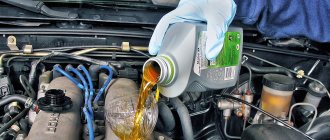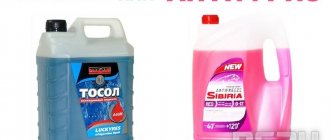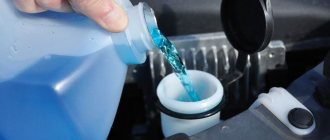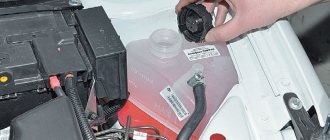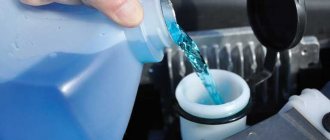If the antifreeze in the expansion tank begins to foam, then the problem is either in the cooler itself, or in the cylinder head gaskets and the block itself. In the first case, they sold you not a high-quality product, but an outright “mash” that was bottled somewhere in a warehouse independently.
The second option is the banal wear of gaskets that have served their purpose. The rubber bands no longer provide proper compression and begin to “blow out”. Although the reason may lie in the cylinder itself, in this case more serious intervention is required. The third reason is the systematic development of the second, or rather its serious consequences.
Low quality antifreeze
Why does the coolant foam in the expansion tank? For an experienced driver, the issue does not seem serious, but beginners should deal with this issue. Antifreeze is a liquid that helps cool the engine from overheating. In other words, the composition protects the engine from deformation at elevated and critical temperatures. Thanks to its special formula, it does not freeze in severe frosts, which is especially important, since it is in winter that a car is especially demanding of cooling.
Foam in antifreeze is often the result of purchasing a low-quality cooler. The composition must circulate throughout all key components of the car at all times, even during warm-up. Circulation is possible thanks to a special pump.
With its help, the coolant is evenly distributed among the components and key points of the chassis, ensuring uniform heating.
If you fill the “palenka”, the principle of distribution will not change, but the air in the expansion tank will begin to come into contact with the chemical elements of the cooler, as a result of which the liquid will begin to bubble, coke and foam will appear.
There are often cases when the final “substance” becomes brownish-brown, which indicates low quality antifreeze.
Methods for removing foam
Let's consider 3 key problems:
- poor quality product;
- wear of gaskets;
- problem with cylinder head and engine
Poor quality cooler
If antifreeze foams, the situation is corrected quite easily, and does not require serious intervention from the service center and auto mechanics. It is enough to drain the mud that was poured in earlier, then pour in distilled water with citric acid and carry out several startup cycles so that the composition completely cleans the pipes, radiator and key components in which plaque could form.
Next, high-quality antifreeze is poured in, which corresponds to the specifications of your car’s engine. The whole process takes about half a day.
Worn gaskets
Foam in antifreeze can also appear if you do not pay attention to the cylinder head gaskets. Many people think that this is not an essential detail that “works and is fine.” Only the failure of this element makes many grab their heads and run to the service station.
The gasket (bleeding) between the cylinder head and the block plays an important role . Why does the composition foam because of this? What functions does this seemingly insignificant rubber band perform? It prevents excess moisture from entering the cylinder head into the blocks themselves. As soon as damage occurs, the gasket becomes a place for free passage of liquids and air into the expansion tank.
And if you add to this the working power and elevated temperatures, then, based on the laws of physics, foam cannot be avoided. Foam in antifreeze does not appear immediately and in small quantities.
If you do not stop it right away, the bubbles will become larger and larger, and the composition will turn into one continuous foamy mass. A related issue is the appearance of smoke and temperature fluctuations. It's funny that the car displays the correct temperatures on the sensors.
Prevention measures
Since you now know why antifreeze foams, arm yourself with the following tips:
- change the cooler in a timely manner, while the choice between imported and domestic composition is not fundamental, it is just a matter of taste. The key point is the quality, manufacturer and characteristics of the cooler. You must realize that “self-made” will damage the car and saving will lead to huge expenses in the future;
- With cylinder heads, everything is more complicated, since no one can predict the moment of “purging”. It is simply impossible to calculate the moment when foam pours en masse into the expansion tank. But if the phenomenon begins, you should promptly contact the service.
Danger of boiling antifreeze
If antifreeze boils in the expansion tank, some drivers do not worry about this. After all, experts consider such a process to be quite normal, especially if the power unit is heated to a temperature of 90-95 degrees Celsius.
But if the antifreeze is boiling, then there should be no loss of it, as well as leaks and other signs. When the technical fluid circulates in a large circle, some of it is discharged into a container intended for this purpose. Novice motorists in such a situation may consider that the antifreeze has boiled. But in fact, something completely different happened: excess fluid was dumped.
But not every bubbling of antifreeze can be called safe for the “health” of the engine. If this happens when the power unit is in a cold state, and side symptoms appear, then this is a serious reason to check the condition of the system. The main signs that eloquently indicate the presence of a malfunction are:
Problems with the reservoir cap and built-in valves are not serious problems. But still, one should not take such problems lightly. Otherwise, antifreeze will begin to quickly leave the system. They can also cause overheating of the power unit. If this happens, the fan will turn on very often while driving.
Coolant leaking from the reservoir
Another problem that raises questions is the release of coolant from the expansion tank. What contributes to this? There are several reasons, but the key one is wear and tear of the cooling system. During operation, pipes and connecting hoses experience noticeable pressure from hot liquid, so during prolonged operation, emptying of the tank may not begin as planned - it will begin to be pushed outward rather than spreading through key systems.
However, the problem is not limited to used vehicles. The cause may also be a faulty tank on a new car. This is all due to the low quality of components or factory defects. Burrs on the neck indicate that the lid is not screwed on tightly and will begin to “spit out” the contents through the gap.
Another reason is the tank itself, or rather the plastic from which it is cast. Low-quality plastic simply cannot withstand internal pressure and breaks. At the same time, antifreeze generously pours over the engine and engine-related components. Maybe fill the candles with special luck.
Results
As practice shows, trying to save 99% on antifreeze turns into a serious problem. Some people allow it out of ignorance. Others, guided by the principle “nothing will happen if I fill these 2 bottles,” understand the mistake only after a while, when they shell out a round sum for engine repairs and a complete replacement of a radiator clogged with sediment that cannot be cleaned.
Make it a rule to do a scheduled inspection of the expansion tank every week for the presence of foam . The process is gradual, so timely detection of the problem will avoid serious consequences. Systematically monitor the quality of the antifreeze being poured. Ask experienced car owners with the same car where they purchase the cooler. You can save on washing, but not on consumables - it will cost more.
Cylinder head gasket
Perhaps the most common reason for the formation of foam in the expansion tank is a leaky gasket under the cylinder head (cylinder head). However, with this malfunction, there are three scenarios for the development of events with different manifestations and varying degrees of danger to the motor.
- Exhaust gases from the cylinders began to penetrate the cooling system. In this situation, exhaust will begin to be pumped into the cooling jacket. This will happen because the pressure in the combustion chamber will be higher than in the cooling system. In some cases, when the tunnel punched in the cylinder head gasket between the cylinder and the cooling jacket is large enough, antifreeze will be injected into the cylinder during the suction stroke due to vacuum. In this case, there will be a drop in the level of antifreeze in the system and characteristic steaming from the exhaust pipe. In terms of car operation, this breakdown will manifest itself as systematic overheating of the engine due to gas locks. The foam itself in the tank will look more like bubbling soapy water. The antifreeze may darken slightly, but will not lose its transparency or its working properties.
Other reasons
There are two more malfunctions that answer the question: why does antifreeze foam in the expansion tank.
- Unsuitable or poor quality fluid in the system. There is a known real case when an independent but inexperienced girl driver poured ordinary glass washing liquid with a fragrance into the cooling system. Naturally, such a mixture not only slightly tinted the tank and forever imprinted the trace of this ridiculous mistake, but due to the presence of surfactants it foamed. Such errors are not critical and will not lead to a sudden failure of the internal combustion engine. You just have to flush the system and fill it with standard coolant. A rare case today, but antifreeze can also foam in the expansion tank due to poor quality.
- Overheating of the motor with simultaneous malfunction of the steam valve. In this case, some of the coolant is observed splashing out through the valves in the form of a hissing, foaming mass. Under normal conditions, when the valve in the plug is working properly, the coolant will intensively and quickly splash out of the system when it overheats. If the plug does not function as it should, this can lead to rupture or tearing of the pipes from their seats and even destruction of the radiator.
The conclusion here is simple: do not use unsuitable fluids for the cooling system and monitor the engine temperature.
About the operation of the cooling system
Often while driving, especially when it is hot outside, the antifreeze in the expansion tank boils. Why this happens and how to fix it is of primary interest to the car owner. To eliminate the malfunction, you need to understand how the cooling system works. Otherwise, it will be quite problematic to identify the cause of the problem and fix it on the spot.
ATTENTION! A completely simple way to reduce fuel consumption has been found! Don't believe me? An auto mechanic with 15 years of experience also didn’t believe it until he tried it. And now he saves 35,000 rubles a year on gasoline!
When starting the engine, it is in an unheated state. Therefore, antifreeze circulates only in a small cooling circle. It includes:
- engine water jacket;
- stove;
- thermostat.
At this moment, the liquid level in the tank is within normal limits. As the power unit warms up, a large circulation circuit begins to open, passing through the main radiator. This leads to the fact that the volume of technical fluid in the system expands. Its excess ends up in the tank. As the pressure increases, it is partially relieved using a bypass valve. It is present on the lid of the working container.
When antifreeze reaches a temperature of 95 degrees Celsius, it increases in volume to maximum values. Its excess is discharged through the upper radiator pipe. For this reason, many motorists have the impression that antifreeze is boiling in the expansion tank. Any experienced car enthusiast can explain why this happens.
When the engine cools down, the coolant is compressed to its usual volume. The result is a drop in pressure. To avoid a vacuum situation, the bypass valve at this point releases outside air into the system.
Depending on the design of the system in a particular car, the cap with the valve can be installed either on the radiator neck, or placed directly on the tank. In the second case, the release occurs only after the pressure has risen. This working vessel communicates with the atmosphere through an opening present in the plug.
Air entering the cooling system
The radiator cap acts as a seal and maintains high pressure in the cooling system. It also allows excess pressure or fluid to enter the expansion tank. A faulty radiator cap valve can allow air into the system, often causing bubbles in the expansion tank and sometimes foam in the radiator.
To keep the car interior warm, the heater valve allows hot coolant to flow into the heater core. A faucet with a bad face seal or loose heater hose connections will allow air into the system.
The hose connecting the radiator and expansion tank must be sealed at the attachment points. It should not be torn or leaking, because... Air may get inside, and then bubbles will appear in the expansion tank.
A failed water pump seal will leak air from the intake or suction side. This causes bubbles to form. They can be noticed when the air captured by the pump reaches the radiator inlet neck or expansion valve.
Actions to take when antifreeze boils
Thus, there are many reasons why antifreeze or antifreeze boils in the expansion tank; it is not difficult to diagnose them. But everyone should know the necessary actions when such a problem arises.
When the coolant temperature indicator in the vehicle interior shows a value above normal while driving, you should immediately set the maximum temperature and power on the climate control system. As a result, excess temperature from the coolant will be transferred to heat the car. After completing this action, you should drive smoothly, without jerking, to the nearest workshop or parking lot.
When the engine overheating lamp comes on while driving, you should stop and turn on the warning triangle. Next, you should turn off the engine so that it cools down; it is not recommended to start driving; it would be better to call a tow truck to take the car to a car service center.
If smoke begins to come out from under the engine in clouds, then you need to stop and open the hood to cool quickly, but under no circumstances should you open the expansion tank cap, the temperature there can reach 200–250 degrees.
When topping up, you should use the same brand of antifreeze; water can also be used, but it is advisable that it be distilled; top up only when the antifreeze stops boiling.
Thus, there are reasons for boiling liquid to cool a car engine, they can be solved in different ways. Every motorist should know them because not a single car is immune from such a problem.
Boiling antifreeze is an unpleasant phenomenon that occurs when frequently standing in traffic jams or operating a car in difficult conditions. To avoid trouble, you should know the causes of coolant overheating and how to combat this phenomenon.
Thermostat malfunction
Under normal operating conditions, the thermostat must open fully to ensure an uninterrupted flow of coolant. They must also close to allow the antifreeze to heat up quickly during cold engine starting conditions. If the thermostat mechanism gets stuck in the open or closed position, then this will lead to overcooling or overheating, respectively. A faulty thermostat may open and close spontaneously, foaming the fluid and causing bubbles in the radiator and expansion tank. Rapid opening and closing of the thermostat valve will cause noise inside the radiator because the liquid will flow in uneven bursts.
Foam in the radiator due to burnt gaskets
Burnt or failed head gaskets are one of the most common obvious causes of coolant bubbles. If the gasket burns out between the cylinder and the water jacket, then compression gases will enter the latter, and air will leak through the head into the cooling system. Due to a damaged head gasket, abundant formation of bubbles occurs in the radiator and expansion tank. As a result, this leads to rapid overheating.
conclusions
However, in any case, it’s worth visiting trusted auto mechanics and conducting an extraordinary inspection of the car - believe me, it won’t be superfluous.
Every car owner should know why antifreeze boils and what actions to take in such a situation. The problem is usually caused by several reasons related to certain vehicle malfunctions. The result, in this case, is obvious - overheating of the engine, and in the most difficult cases, its destruction.
Based on physical properties, antifreeze should boil at a temperature of 100 degrees Celsius. In practice, vehicle manufacturers increase this parameter to 108 degrees. As for regular types of antifreeze, they also boil at a specified temperature. It is impossible to determine this parameter with an accuracy of one degree, because this is the prerogative of each individual manufacturer.
What malfunctions cause antifreeze or antifreeze to boil?
Failures can be associated with several components of the car, each of which will be discussed below.
water pump
The reason why the antifreeze boiled may be the ineffective operation of the water pump of the cooling system. This malfunction is typical for engines in which the pump pulley rotates using a separate timing belt. To avoid problems, it is important to check the tension of the belt drive and, if it is loose, make adjustments. In another situation, antifreeze moves through the system at a lower speed and removes heat from the engine less well.
Cooling radiator
If antifreeze is boiling in your car, pay attention to one more element - the radiator of the cooling system. It may fail for the following reasons:
- Scale has appeared on the inner walls of the pipes, which significantly reduces the thermal conductivity of the pipes. The result is that the antifreeze does not cool quickly enough and does not remove heat well.
- The inside of the radiator is contaminated with debris that may be present in the coolant. As a result, the throughput of the device decreases and the efficiency of the system as a whole decreases.
- The car moves for a long time at low speed. This problem is relevant for big cities, when the car owner gets stuck in a traffic jam, or for off-road driving. As a result, the vehicle moves slowly for a long time, and the air flow passing through the radiator is not enough for cooling. If antifreeze boils in such a situation, you should “sin” the fan, which did not turn on when the temperature rose.
This is what a clogged radiator looks like
Thermostat
Another reason that can lead to antifreeze boiling is the failure of the temperature control device (thermostat). With such a breakdown, the valves remain in a fixed position, and the antifreeze always flows in a small circle, that is, without gripping the radiator. Restricted circulation leads to rapid overheating of the coolant in the system. If the antifreeze boils, you should carefully open the cap of the expansion tank, allowing extraneous vapors to leave the system.
To verify whether the thermostat is working or failing, open the hood and find the two pipes that are connected to the device. It is through these tubes that antifreeze is directed to and away from the radiator. Touch the hose that supplies antifreeze to the radiator and compare it with the outlet pipe. If the first is hotter than the second, then the thermostat requires replacement.
The reason that antifreeze is boiling may be its low level (checked by special marks in the tank) or a fan failure.
What does boiling lead to?
Many car owners underestimate the danger to the engine and continue driving, even when the antifreeze overheats. Such actions can lead to a number of troubles, including engine damage.
Experts distinguish three levels of engine overheating due to the boiling of antifreeze - weak, medium and strong. Let's look at each of them in more detail.
Slight overheating
If no more than ten minutes have passed since the antifreeze boiled, then problems are excluded. At the same time, we can say that the car owner was lucky. The cause of this unpleasant phenomenon may be a breakdown of the thermostat or fan installed on the cooling radiator.
If the signal from the temperature sensor on the dashboard indicates overheating, you should immediately turn off the engine. Otherwise, the engine pistons will not hold up and may begin to melt. For new cars, slight overheating is not dangerous, so there is no need to panic and immediately evacuate the car to a service station. This recommendation is relevant even if smoke is coming out from under the hood.
Average superheat
If more than twenty minutes have passed since the antifreeze began to boil, the consequences may be more serious:
- Cracks or deformation of the cylinder head.
- Melting or burning of the gasket installed between the cylinder block and the head.
- Damage to the partitions between the piston rings.
- Oil leakage in oil seals.
The stages of overheating discussed above (weak and medium) most often occur due to poor quality of vehicle maintenance.
Antifreeze is boiling in the expansion tank
Severe overheating
This problem can lead to motor failure. If antifreeze boils, and the engine temperature has long been outside the permissible limits, then almost all its parts suffer. But even this is not the worst thing. If measures are not taken in a timely manner to stop the engine, it may explode, with unpredictable consequences for the driver, passengers and other road users.
Fortunately, the situation considered rarely happens, and, in most cases, the car owner has time to take primary measures. The result of severe overheating is the development of a “wave of destruction” that affects various elements of the system. First, the pistons burn and melt. Further, the dripping metal hits the cylinder walls, which creates additional interference with the movement of the pistons. As a result, they become deformed.
If the engine continues to operate, even with deformed pistons, problems arise in the lubrication system. The engine oil loses its lubricating properties, which causes the engine's rubbing elements to break. The crankshaft becomes exposed to melting elements, which also impede its rotation.
The result of the described events is the falling out of the valve seats and the mechanical impact of the pistons on the crankshaft, after which its destruction occurs. At the final stage, the piston breaks through the wall of the cylinder block, and the engine becomes inoperable.
Coolant boiling
Over time, radiators rust and oxidize, especially if they are not flushed and the proper ratio of antifreeze to water is not maintained. Particles of rust, slime and dirt will clog the radiator core tubes and interfere with the thermostat and water pump impeller. Excessive heat and rust will cause the coolant to boil and create small bubbles that can be seen in the radiator neck or expansion tank.
Air pockets in the cooling system are usually the result of a poorly flushed or incompletely filled radiator. Plugs lead to a decrease in fluid volume, which often affects the operating temperature. As a result, air bubbles are visible through the radiator inlet neck or in the expansion tank.
>
Reasons for antifreeze boiling in the expansion tank
So, the easiest and most quickly solved problem for the driver is the insufficient level of antifreeze in the expansion tank. If it is not enough, then the heating of the coolant in the system increases, the antifreeze overheats and boils.
In this case, the antifreeze either has not been changed for a long time and has lost its properties, or it was not completely filled to begin with. In this case, you need to add the required amount of coolant to the level between o and “max” on the expansion tank body.
If the antifreeze level continues to drop, it means that the seal of the expansion tank or cooling system is broken and the liquid is leaking. In this case, it is necessary to check the tank, pipes and hoses, and look for a leak. If the problem cannot be resolved, it is necessary to check the tightness of the cooling system at a service station.
- Also, the cause of bubbling in the expansion tank may be a malfunction of the thermostat. It maintains the optimal engine temperature, regulates the temperature of the antifreeze circulating through the large and small circuits of the cooling system.
When 90°C is reached, a special valve between the circuits opens, the coolant flows from the small circle to the large one, then cools as it passes through the radiator. If the thermostat breaks down, this valve jams, the antifreeze does not cool down and bubbles in the expansion tank.
To check the serviceability of the thermostat, you need to turn off the engine, open the hood, inspect the pipes and compare their temperature. If one of them is cold and the other (attached to the radiator) is hot, this means that the problem is in the thermostat. In this case, you need to change the thermostat.
- If, while driving, the coolant temperature indicator located in the car interior shows normal, but the antifreeze still boils, then the problem is in the pressure, since as the temperature rises, the pressure on the liquid also increases, causing it to also boil.
Another reason for antifreeze boiling may lie in the insufficiently efficient operation of the cooling radiator. One way or another, the radiator is not able to provide sufficient cooling of the coolant and protect the engine from overheating, especially in the heat of a traffic jam. Then just turn off the engine to let the car cool down.
As for clogging of radiator tubes, in this case their thermal conductivity decreases. As a result, the cooling capacity of the radiator is reduced. The reason is the accumulation of deposits in the pipes (often after using low-quality antifreeze).
Often scale forms in the radiator, as a result the circulation of the coolant deteriorates and it boils. A dirty radiator needs to be immediately flushed at a service station or replaced.
- Also, the problem of insufficient coolant cooling in the radiator is solved with the help of a fan mounted on the radiator. It turns on automatically when the antifreeze temperature rises above 90°C and blows cold air over the engine to prevent overheating.
However, the fan itself often fails. If the engine temperature is 100°C, steam is flowing, and the fan does not rotate, this means that the cause of overheating and boiling of antifreeze is in the fan. Its breakdown can also be determined by ear: when the cooling fan is not working, the hot engine runs relatively quietly.
Currently reading
Installation and repair of the muffler resonator
How often to change the timing belt on a car: what you need...
- Even after replacing the antifreeze in the cooling system or when air leaks, air pockets sometimes appear, impeding coolant circulation. You can get rid of them if, with an assistant, you drive up a hill in front so that the radiator is at the highest point. Next, you need to unscrew the radiator cap, start the engine, press on the cooling system pipes until the air pockets are eliminated. At the same time, the assistant should accelerate intensively. Then screw the radiator cap back and add the missing amount of antifreeze.
Low-quality antifreeze is the shortest route to engine problems. Such coolants are cheap, but they clog individual elements (the radiator) and contaminate the water pump that circulates the antifreeze. Low performance of the water pump leads to boiling of the coolant, and the pump itself quickly rusts.
It is important to remember that operating a machine with a damaged pump will lead to engine damage. In this situation, the car must be delivered to the service station using a tow truck or towed by another car.
- Let us add that a burnt cylinder block gasket causes antifreeze to boil. In this case, the tightness of the cooling system is compromised. The coolant may end up in the exhaust, bubbles appear in the tank, and the coolant level decreases. In this case, the gasket must be replaced.

